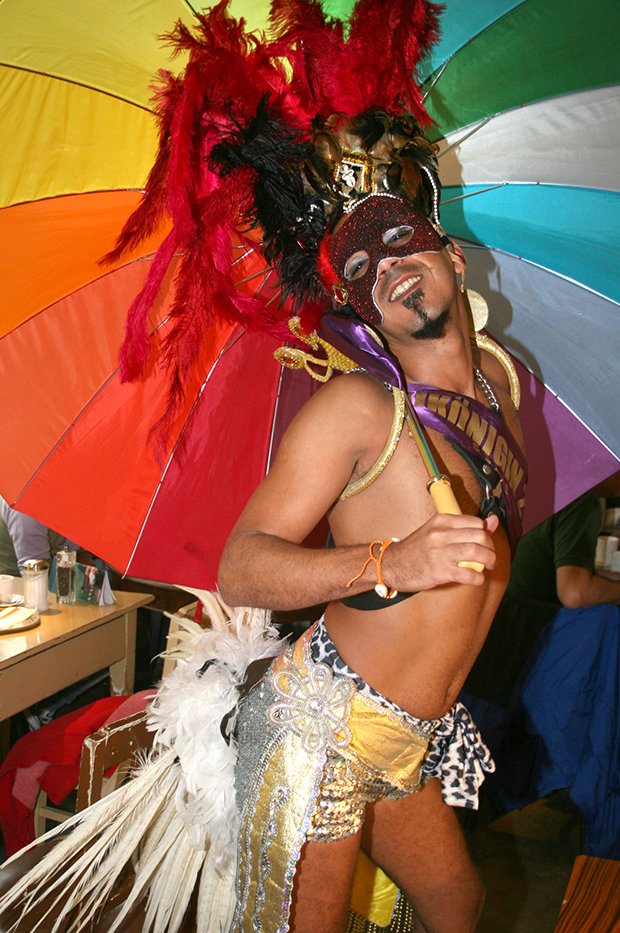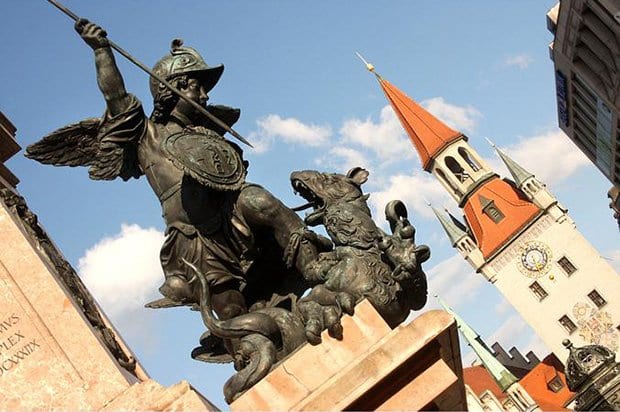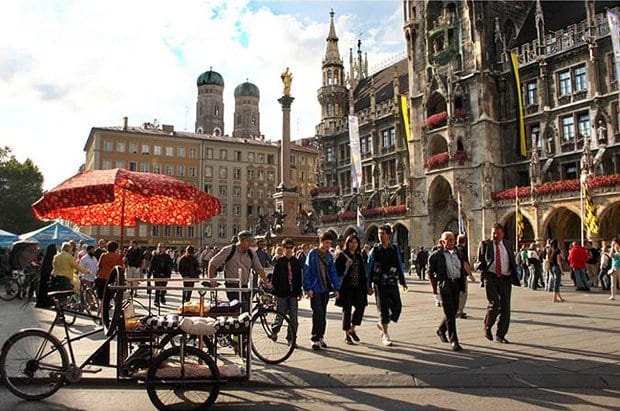
Munich's Christopher St Day, held in July, includes a parade through the gay neighbourhood and a street festival at Marienplatz. Credit: Mike Thompson

Credit: Guidemag files
Munich, the capital of Bavaria, in the south of Germany, has a very different feel from much of the rest of the country. Still, many of the traditional things associated with Germany — from pretzels to dirndl to lederhosen to Oktoberfest — all come from here.
Until the early 1900s, Bavaria was its own kingdom, and it remains a largely Catholic region. Munich dates back to the 12th century, if not earlier, and though it’s a large city today, it retains a small-town provincial feel. Allied bombing damaged Munich heavily in the Second World War, but much of its original architecture was rebuilt. This emphasis on preservation gives Munich a charming whimsy, especially throughout its centre, that you won’t find in Berlin or many other German cities. For that alone it’s one of my favourite places to visit in Germany.
The heart of Munich is Marienplatz, originally an old medieval market. The neo-gothic New City Hall, completed in 1909, dominates an entire side of the plaza. Its main highlight is the glockenspiel, or clockworks, an elaborate two-level clock that tells stories about a noble marriage and the bubonic plague through dancing puppet-like characters. Every day at 11am, noon and 5pm, the clockworks are set in motion. The Old City Hall, built in the late 1400s to replace an earlier structure, is also on Marienplatz. Resembling a church, with its angular front and spire, it was partly destroyed in the war and rebuilt to exacting standards. Other historical monuments and fountains abound in Marienplatz.
The most famous building in Munich is the Frauenkirche, also built in the late 1400s by the same architect who built Old City Hall, Jörg von Halsbach. Its prominence is ensured by Munich’s height restrictions, which allow it to dominate the cityscape. It too was heavily damaged in the war but meticulously rebuilt. The towers are capped by distinctive round-button domes, said to be modelled on Jerusalem’s Dome of the Rock. A delight of Munich is to climb the south tower for its view of the surrounding city.
Gay life in Munich
You’ll find a warm welcome in Munich, with much of gay life focused within a few blocks of Sendlinger Tor, one of the old city gates dating from when Munich had a surrounding wall. You’ll find a cluster of businesses on or near Müllerstrasse, such as Edelheiss, a bar popular with bears (Pestalozzistrasse 6; edelheiss.de). Nearby is the modern and stylish M54 Sauna, with half-hour massage treatments starting at 35 euros. (Mullerstrasse 54; muenchengaysauna.de). The Sendlinger Tor Park gets a little bit cruisy, too.
One of Germany’s most popular gay tour companies, Tom on Tour, is based in Munich. It’s run by Thomas Bömkes, who says that “Munich has a lot to offer the tourist. It’s easy to walk around and a very historical city. We have everything from charming neighbourhood gay bars, like the Ochsengarten, the oldest gay bar in Munich, to beautiful, well-preserved architecture. Everyone speaks English, too, so it’s great for Canadians and Americans who want to visit.”
Tom on Tour’s website has more information on gay venues in the city (tomontour.com), and you can contact the company to book gay-friendly city guides or special Oktoberfest travel packages.
Gay pride in Munich, as in almost all of Germany, is called Christopher St Day. A weeklong festival, in 2012 it will be celebrated from July 7 to July 15, with a parade on July 14. Visit csd-munich.de for more information.
By the way, the German word for gay is schwule, so whenever you hear that, you know something gay is happening.
Oktoberfest
Throw a really good wedding celebration and the locals will want to celebrate in the same style year after year. That’s the case with Germany’s most famous party, the Oktoberfest, which originated in Munich. The event owes its origins to the wedding of Crown Prince Ludwig and Princess Therese of Bavaria on Oct 12, 1810. Locals were allowed to throw their own party to celebrate on a field outside the city, now called Therese’s Meadow, known by locals as Wiesn. An agricultural festival was eventually added to the celebrations, and the Oktoberfest became a Bavarian tradition emulated the world over, with people dressing in lederhosen and dirndl and swilling beer. Munich’s Oktoberfest 2012 will run from Sept 22 to Oct 7. Visit oktoberfest.de, the official website of the event for more details. Gay highlights of the festival include Pink Wiesn (rosawiesn.de) and the Oktobearfest (oktobearfest.de).
Gay King Ludwig II
The gayest thing in Bavaria isn’t a bar or a sauna — it’s a castle. Even if you didn’t know where it was or its name, you’ve certainly seen images of Neuschwanstein Castle, a mist-shrouded, neo-medieval, fairy-tale structure nestled in the mountains. It’s been used for numerous movies, including Chitty Chitty Bang Bang. Neuschwanstein was the work of King Ludwig II, sometimes known as Mad King Ludwig, who built similar castles elsewhere in Bavaria. It’s not hard to believe that a man who built such romantic castles, liked historical costume and was a huge opera buff (and a patron of Richard Wagner) was also gay. It’s likely that one of his lovers was Richard Hornig, who was in charge of the horses. Ludwig’s own diary and letters serve as proof of his relationships with men, though exactly how he identified himself within the era is not fully known. Ludwig died young under mysterious circumstances; found in Lake Starnberg, his death was ruled a suicide, but some believe he was murdered by his enemies.
Englischer Garten
Englischer Garten (English Garden) Park, bigger than New York’s Central Park, is a sprawling area of woods and lawns in the middle of Munich. Scientist Benjamin Thompson of Woburn Massachusetts was a loyalist, driven from his New Hampshire home during the war of 1776. He found a new home in London, and then in Munich under Duke of Bavaria Karl Theodor, for whom he established this park in 1789. Modern visitors flock to the Monopteros greek temple by distinguished local architect Leo von Klenze; the Chinesischer Turm with adjacent beer garden; and Japanisches Teehaus and garden on a small island. The Schönfeldwiese (“beautiful meadows”) area is famous for the nude sunbathers who decorate the lawns, and of course this park can be quite cruisy too.
Isar River frolics
The Isar River ranks among Munich’s greatest charms. The waters flow from the Tirol Alpine region of Austria. Allowed to run naturally, its tributaries are little islands edged with sand or pebble beaches, big flat rocks, and meadows of grass and wild flowers. All kinds of people come to the water on warm summer days — families with children, goth teens, gay couples, and gatherings of friends of all ages and ethnicities. Over barbecues and beer, they populate the riverside, bike the nearby trails, throw frisbies, read or doze, all mingling together without fuss or offense to one another. Nude sunbathers turn golden brown, and activities on the gay cruising trails aren’t hard to spot, among trees of the larger island just beyond the downriver footbridge. Alongside this, kids and dogs frolic, and lovers — straight and gay — get wrapped in private worlds of their own. This area is easily reached by U-Bahn; go to Thalkirchen station and follow the people with beach gear. Munich’s famous zoo is nearby as well.
Viktualienmarkt
King Maximilian I established this “victuals market” in 1807 to serve the residents of this growing city with a central place to buy food. Major additions were made from 1823 on, with more halls added as needs arose. Fish markets, fowl and other meats, flowers, produce, and bakery items each had their own pavilions. Like most of the city it was severely damaged in the war, but mostly restored, with fountains and other embellishments added during the reconstruction. A favorite of modern gourmets, the market covers 5.5 acres with over 140 shops and stalls, and beer gardens, offering most every kind of ordinary and exotic produce, meat, fruit, flowers and plants, dairy products, honey, fish — and a wide variety of sausages. This area is also the site for many festivals and special folk events year-round, with music, dance, prepared foods, and always plenty of beer to wash it down, and make people festive.
Getting there
Franz Josef Strauss Airport, about 30 kilometres northeast of Munich, is one of Europe’s best. A shopping, business and recreation area that connects the two terminals is full of people from every corner of the globe. The S-Bahn S1 and S8 trains will get you to the Hauptbahnhof or Ostbahnhof central rail stations in 33 to 53 minutes, depending which train you take. Each takes a different route, so for points in-between consult the website. There is also bus service to various destinations. The main information desk, at level 3 of the Central Area, is staffed 24 hours. Information desks are located in each terminal building, from at least 5:30am until 10pm.
Getting around
Munich’s historic, largely car-free centre is very walkable, and, with designated bike lanes on most major streets, it’s great for cycling. There’s a network of buses, trams, and U-Bahn and S-Bahn trains at your disposal. Trams offer late-night service and are perfect for getting home after a night on the town. Inexpensive one- and three-day visitor passes are available at the stations and at many tram stops. Visit mvv-muenchen.de for tranportation info in five languages. To get around in the principal gay area, around Müllerstrasse and Hans-Sachs-Strasse, you needn’t stray far from stops on tram routes 17 and 18, or the vicinity of the Sendlinger Tor U-Bahn station.
For map locations and website links to almost 100 area places of interest see our gay Munich listings pages.
Munich Tourism Office
muenchen.de
Oktoberfest
oktoberfest.de
MVV public transportation
mvv-muenchen.de

 Why you can trust Xtra
Why you can trust Xtra